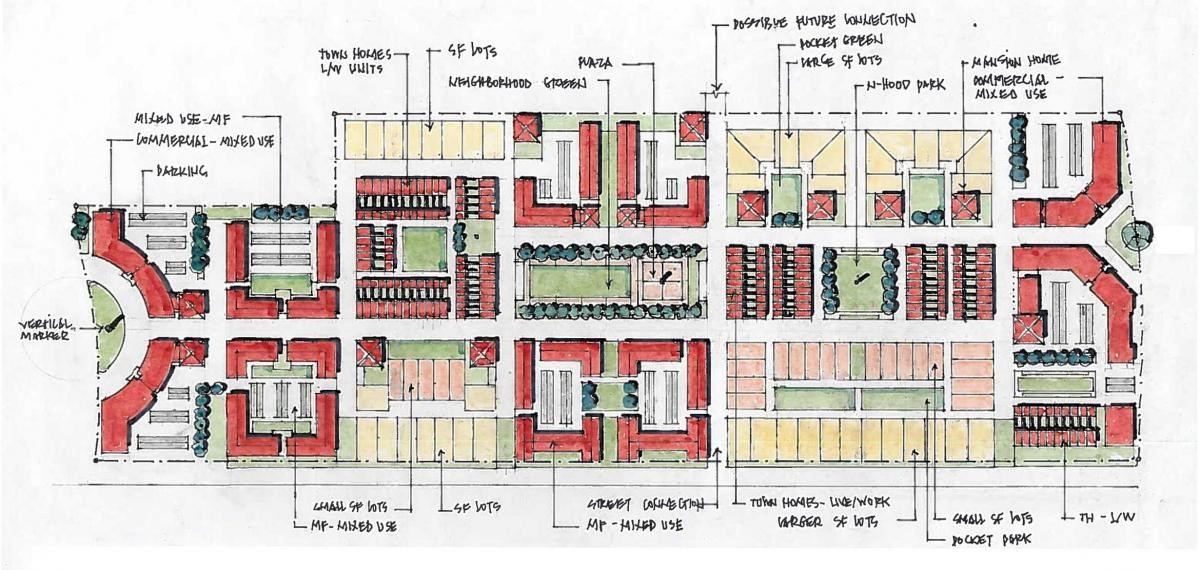Is There a Model Zoning Code?
Zoning Has Done More Harm than Good in America. But the Code Rewrite in Bastrop, TX Takes Zoning in a More Liberalized Direction.

Zoning—a form of land-use regulation that polices the design and use of buildings—has had a bad run in America. Legalized in 1926 by the Supreme Court as a public protection to separate noxious uses, it’s since metastasized into something that micro-manages many aspects of city life. Zoning has been blamed for worsening the affordable housing crisis, inducing car-reliant sprawl, and squelching bottom-up entrepreneurship.
But zoning isn’t going anywhere. Almost every city has it, and the legal ability for change is limited. The question is: how can zoning at least be reformed to better enable market outcomes and reduce its high social costs. A recent code rewrite in Bastrop, TX embraces that goal.
The 8,800-person city recently adopted Bastrop Building Block (B3), a comprehensive rewrite of its zoning code. The point is to ensure fiscal sustainability and mitigate against environmental damage. The code, said city manager Lynda Humble, will effectively extend the downtown land-use paradigm further into the 9sqmi city. In this respect, B3 will be different than most U.S. zoning codes: rather than copying the Euclidean model of sprawl and separated uses, it will mirror the “form-based” model of walkable streets, mixed uses, and urban density.
Certain conditions have led to this measure in Bastrop, a historic city 30 miles east of Austin. Situated on the Colorado River, these last few years it has experienced multiple floods, wildfires, and a hurricane. Another city issue (due in part to these weather problems) is the prospect of fiscal unsustainability. According to an analysis by an outside consultant, downtown Bastrop generates the most revenue for the city, while its sprawling areas lose money due to infrastructure maintenance costs mixed with low property tax generation. So B3 is designed to replicate what works, while avoiding development patterns that create liabilities.
Bastrop will do this through a Transportation Master Plan that extends the downtown grid to under- or undeveloped areas, via the construction of narrow, tree-lined streets. This contrasts with the wide, winding, subdivision-style streets that dominate many U.S. cities once you tread outside downtown. The narrower streets should reduce flooding, since there will be fewer impervious surfaces; reduce costs, since there’s less asphalt; and improve walkability. Existing blocks will also be subdivided into smaller 385’ ones, another measure that will benefit the pedestrian realm.
The other noted aspect of B3 will be zoning that’s more permissive, and that features various urbanist best practices. Like other form-based codes, B3 regulates nuisances rather than uses. This means there will be more potential to mix retail and residences, a trademark of early U.S. urban growth. The code has no parking minimums, and shared parking is encouraged. There will be no lot-size minimums, meaning extremely small businesses or housing is allowed. Every lot can have at least three units—the main home, and two accessory dwellings.
“Our code,” said Humble, “takes all of the elements of pre-suburban sprawl and incorporates them into a code that allows us to go back to what we know.” Matt Lewis, CEO of Simplecity Design, the consulting firm that helped with B3, added that the code is an act of “reestablishing the traditional American grid.”
To address the flooding problem, B3 allows property owners more flexibility in preventing runoff from their own lots. Rather than being forced to build driveways—as is common elsewhere—lot owners can use pervious pavement alternatives and install drainage swales.
What made B3 politically possible, when similar initiatives haven’t been in other cities, was the ideological mindset of Bastrop. It votes Republican in presidential elections, and arguments about fiscal sustainability and limited government appeal there, said Humble. So, when the city was able to demonstrate that certain development patterns don’t pay for themselves, it found support for change. Whether or not those arguments work elsewhere, Bastrop at least provides a framework for how other cities could write more liberalized zoning codes.
“Cities are requiring bad development practices; we’re over-regulating to such an extent that it’s harming good developments,” said Lewis. The point of B3 is to reverse course, by “going back to the core principle of what we’re trying to design our communities to function like. This is an applicable tool that could work in large cities.”
Catalyst articles by Scott Beyer | Full Biography and Publications
